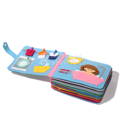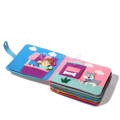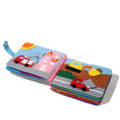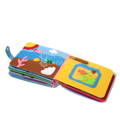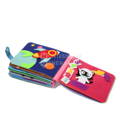Montessori Story Book: A Closer Look
You know how kids can be fascinated by the most ordinary things? Like watching a washing machine go round or staring at a construction site? These everyday scenes can really spark their imagination. It's also how they try to understand the world around them.
The Montessori Story Book is like that but with a twist – it's interactive. So, while they're exploring stories from real life, they're also touching, pulling, and engaging directly with the scenes, making their learning even more hands-on.
Want to know more about it? Let's dig into what makes this book so unique.
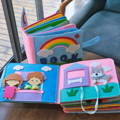
What is the Montessori Story Book?
At its core, the Montessori Story Book is a 16-page journey for kids aged 2 and up. Think of it as a regular picture book but with a special twist. Instead of just illustrations, it's made up of soft, felt scenes. This means kids can touch and feel every part of the story, literally.
Why no words? It's intentional. Words can sometimes limit imagination, but with this book, there are no boundaries. Kids can look at a scene and come up with their own story. Maybe today, the boy is selling apples at his stand, but tomorrow? He could be showcasing his toy collection.
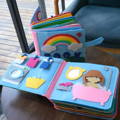
The Stories of the Montessori Story Book.
Now, let’s talk about the scenes in this book. Each page captures a slice of everyday life, making it familiar yet fascinating for children. From doing laundry to spending a day on the beach, it's all about relatable experiences that kids see around them.
What’s Montessori about It?
Alright, so you've heard of Montessori before, and you're probably wondering, "How does this book fit into the whole Montessori thing?" Let's break it down.
Dr. Maria Montessori, the founder of the Montessori method, believed in creating an environment that aids in children’s natural development. In simpler terms, it's about letting kids be kids and learning through experience.
This book embodies that philosophy. Instead of spoon-feeding stories or limiting a child to a fixed narrative, it encourages exploration. It’s like giving them a playground on paper (or, in this case, felt). The idea is that children learn best when they’re actively engaged, making discoveries, and drawing their own conclusions.
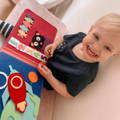
Why Real-life Tales? The Power of Relatability
By focusing on real-life tales, this book resonates with what children see, hear, and experience daily. This familiarity offers comfort and an immediate connection. When kids recognize a scene from the book in their own surroundings, it reinforces their understanding and strengthens their relationship with the world.

Benefits of the Montessori Story Book
Motor skills development: Handling those felt pieces isn't just fun – it's also a mini workout for tiny fingers. Moving, adjusting, and placing objects in the book help refine fine motor skills. It's basic practice today for tying shoelaces and writing letters in the future.
Nurturing imagination: While the book is grounded in real life, it's also an open canvas for imagination. Without fixed narratives, kids craft their own stories, encouraging them to think creatively and build their storytelling abilities.
Preparation for the real world: The book's everyday scenes mean kids aren’t just dreaming – they’re practicing. It’s like a rehearsal for real-world interactions, helping them make sense of what they see and experience daily.
How to Make the Most of Your Story Book?
The Montessori Story Book isn't just a book; it's a tool. And like any tool, it's most effective when used right. If you're a parent or caregiver, here are some tips to help your child get the most out of it:
- Engage, don't direct: Let your child take the lead. Ask open-ended questions like "What do you see?" or "What's happening here?" rather than pointing things out. This encourages them to observe and articulate their thoughts.
- Extend the narrative: After they've told their version of the story, you can build upon it. "What happens next?" or "How did that make the character feel?" This pushes them to think critically and imagine further.
- Connect to real life: If there's a scene about a market, talk about your last visit to the grocery store. "Remember when we bought apples? Can you find apples in the book?"
- Introduce new vocabulary: Use the book as an opportunity to introduce new words. For instance, if there's a scene with a beach, words like "tide," "sandcastle," or "seashell" can be discussed.
- Practice motor skills: While the felt pieces are great for story-telling, they're also a chance to hone motor skills. Encourage actions like pinching, pulling, or placing objects with precision.
- Revisit often: Each reading session can be different. As kids grow and learn, their understanding and interpretation of the scenes will evolve. Enjoy watching their narratives change and develop.
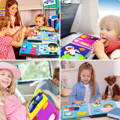
Safety First
We get it: handing anything to those little, curious hands comes with a mental checklist of concerns. Is it safe? Is it sharp? Will they get hurt? With the Montessori Story Book, we had all these questions in mind during its design phase.
Rounded edges: Say goodbye to sharp corners! Each page, element, and detail is designed with rounded edges, minimizing any risk of accidental pokes or scratches.
Sturdy binding: The book is built to be tugged, pulled, and explored. We've ensured a durable binding so pages stay intact, even with the most enthusiastic readers.
Non-toxic materials: Safety isn't just about design; it's about composition, too. We've made sure that the materials used are non-toxic and safe for kids to interact with.

In designing the Montessori Story Book, we aimed for a balance: a book that's engaging for young minds but also puts parents' minds at ease. With its careful design and safety considerations, it's ready to be a trusted companion in your child's learning journey.
Conclusion:
Alright, so here's the deal with the Montessori Story Book. It's like giving kids a map of their everyday world, tailored just for them and made safe with that soft felt design. As they flip through and play, they're not just having a blast; they're also connecting the dots, understanding their surroundings bit by bit.
So, in the midst of all the playtime and stories, there's genuine learning happening. It's a straightforward blend of fun, safety, and day-to-day discovery. Nice, right?
If you want to get your copy, order it on our website: 👇
Free Delivery
Over $80
Easy Returns
No questions asked
Unbeatable Warranty
1-year ++ warranty
- Secure CheckoutWorld’s most secure payment method

